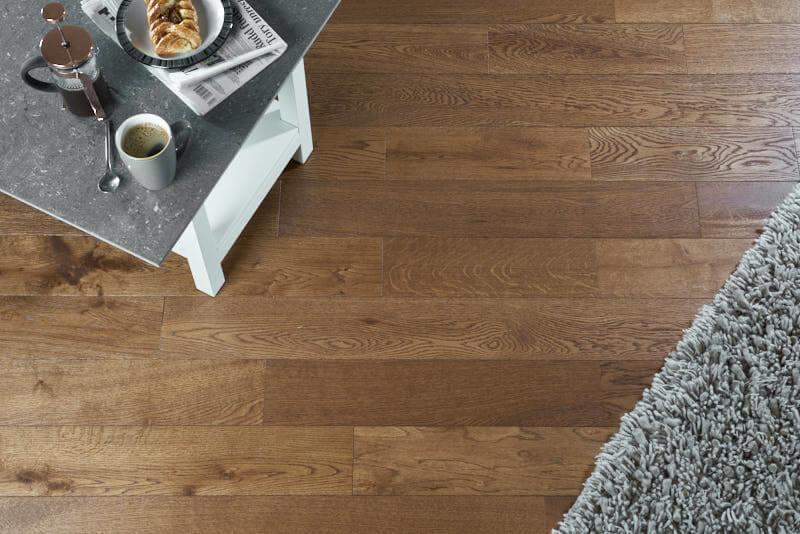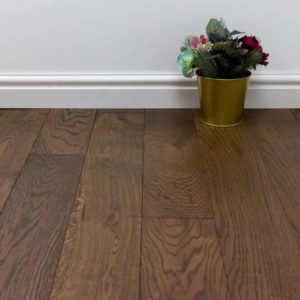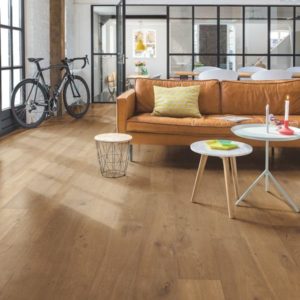Let’s face it, spills and accidents happen all the time in our homes. Whether it’s a spilt drink, dropped food, or just damp creeping in, moisture has a funny way of wreaking havoc with our homes. Your flooring in particular has probably taken a beating when it comes to dealing with moisture.
Flooring of all varieties can be structurally weakened and aesthetically affected by water, so it’s important to do what you can to protect it and prevent damage. Choosing a water repellent floor can save you a lot of time, hassle and stress.
Waterproof Engineered Wood Flooring
Engineered wood flooring is not completely waterproof. It does, however, have more moisture resistance than hardwood flooring, which is due to its construction and structural makeup.
Quick-Step engineered wood floor is a great option if you’re looking for an authentic and water repellent floor. While engineered hardwood flooring itself isn’t actually waterproof, Quick-Step offers a Protect Plus coating that makes it extremely water repellent and therefore a fantastic choice.
Here’s everything you need to know about engineered hardwood flooring, including information about the Protect Plus water resistant coating.
What is Engineered Hardwood Flooring?
In terms of appearance, engineered hardwood flooring doesn’t really look much different to solid hardwood because the top layer is real wood. It has the same authentic and natural look, and it feels the same underfoot. However, it’s manufactured in a different way which gives it additional properties.
While solid hardwood flooring is a single plank made completely out of hardwood, engineered hardwood flooring is constructed using different layers.
The base layer is usually high quality plywood, and the top of the flooring is finished with a layer of hardwood. So you still get the hardwood look and feel, but the actual makeup of the flooring is different.
Engineered Wood vs. Solid Wood
The difference between engineered wood flooring and solid wood flooring is construction. The different layers is what gives engineered wood flooring different properties, making it more stable.
The biggest problem that a hardwood floor faces is adapting to changing temperature and moisture conditions. When wood comes into contact with moisture, or the temperature changes, it will either shrink or expand. With hardwood, this change can cause cracks or buckling. However, the layers in engineered wood flooring mean the floor can move and shift without permanently damaging the floorboard itself.
Engineered wood flooring is therefore much more stable. It is able to withstand moderate changes in moisture and temperature conditions where a hardwood floor could not.
This means that while engineered wood flooring isn’t waterproof, it is moisture resistant and therefore can be a great choice for areas such as dining rooms or living rooms.
Other Differences
Engineered wood flooring, especially top quality brands such as Quick-Step, has some other perks over solid hardwood that many people don’t realise or expect. So here are some things to consider when weighing up whether to choose solid or engineered hardwood flooring.
Affordability
If you’ve already been looking at solid flooring options, you’ve probably seen that solid wood is usually quite pricey. Engineered flooring is a lot more affordable, because the different layers vary in price, making each piece of flooring less expensive to manufacture than a board of solid wood. If you want to get the real wood flooring look, but at a cheaper price, then engineered wood flooring is a great way to do it.
Appearance
While you might think solid flooring would look more authentic, only the most experienced professionals can tell the difference! Engineered wood flooring has a top layer of hardwood and you won’t be able to see what’s below the surface, so it looks identical to solid wood flooring.
Thickness
Both solid and engineered flooring have a similar thickness, but one thing to bear in mind is that engineered floors are only topped with a thin layer of hardwood, rather than being made completely from hardwood. This means it’s not quite as durable and hard wearing as solid wood flooring, which can be sanded down and resurfaced many more times.
Engineered flooring, depending on the thickness, can be resanded and refinished, but fewer times than hardwood floors.
However, a lot of engineered wood floors, such as Quick-Step engineered flooring, shouldn’t need sanding.
Installation
Installing an engineered hardwood floor can be a walk in the park. It doesn’t have to take a long time or cost a lot. There are actually more ways to install engineered flooring than solid flooring, making the process easier.
While solid floor has to be stapled or nailed down, engineered hardwood can be installed using a whole range of methods including click and lock systems and floating floors.
Durability
Engineered flooring can last for years and years. In terms of foot traffic, it’s not quite as durable as solid wood as this can be sanded and refinished many times, while you’ll need to take care not to chip the thin top layer of hardwood on engineered wood floors.
However, the extra stability of the floor improves its durability; it’s less susceptible to damage from water or heat.
Water Repellency
As already mentioned, neither solid nor engineered hardwood flooring is completely waterproof, but engineered floors are much better at coping with moisture than solid wood.
Solid hardwood can be distorted by water — losing its shape, texture and colour — but engineered flooring holds its own when faced with moisture or spills.
This is especially so if you choose Quick-Step engineered wood flooring which includes Protect Plus.
Benefits of Quick-Step Engineered Wood Flooring
There are loads of engineered wood flooring brands to choose from, but Quick-Step is one of the best. They offer affordable flooring solutions of the highest quality, so you can always rest assured that their floors will look good and stand the test of time.
Here are some of the benefits of choosing Quick-Step engineered wood flooring.
A variety of patterns and colours
Your floor should perfectly match your home’s design and atmosphere, so you don’t want to choose just any old flooring, but rather be able to choose from a massive range of colours. You can find an engineered wood floor in a colour that complements your home.
However, it’s not just about colour; the pattern of your flooring can also help to create a rustic, modern or traditional home. Quick-Step engineered wood floors come in a range of styles with different patterns and textures available.
Three solid wood layers for durability
While many engineered flooring brands only create floor boards with a single layer of hardwood at the top, Quick-Step has three layers of solid wood for durability.
This makes the floor extra resistant to moisture, wear and tear, and changing temperatures as the seasons turn. You won’t see the same distortion which solid wood flooring often experiences.
Easy installation
Engineered hardwood is more simple to install than solid hardwood, but Quick-Step takes easy installation to the next level. You can use just about any installation method, and you can make use of the tongue and groove system to easily slot each board into place.
Protect Plus
Protect Plus adds years to your floor’s lifespan. Moisture can be a big issue for both engineered and solid hardwood, but Quick-Step’s Protect Plus coating makes engineered hardwood water repellent.
The coating stops any liquid from seeping into the floorboards or into the gaps in between each board. So if any liquid is split on the floor, you can just mop it up without worrying about it seeping into your flooring and causing distortion. This is going to save you time and stress, and, perhaps most importantly, money on maintenance!
Quick-Step engineered wood flooring is the perfect choice of floor for almost any room as it’s more moisture resistant than standard engineered wood flooring.
While engineered hardwood flooring is not completely waterproof, there are engineered flooring options that provide additional protection, such as Quick-Step’s Protect Plus.


